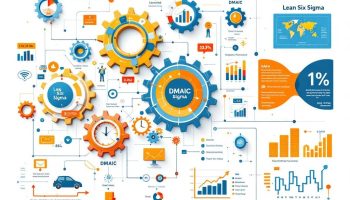
BPM Modeling Tools: Essential Solutions for Organizational Efficiency
BPM modeling tools have become essential solutions for boosting organizational efficiency. These tools help businesses visualize, design, and optimize operational processes with precision. Through intuitive interfaces and advanced features, companies can streamline workflows, spot bottlenecks, and implement continuous improvements across departments.
Key Takeaways:
- BPM modeling tools democratize process design by offering user-friendly interfaces accessible to both technical and non-technical professionals.
- Advanced visualization capabilities help organizations convert abstract processes into clear, standardized representations.
- Automation functionality eliminates repetitive tasks and enables teams to focus on strategic initiatives.
- Real-time collaboration features support distributed workforces and enhance team communication.
- Integration capabilities with enterprise systems create a cohesive technology ecosystem for seamless process management.
With BPM modeling software, you’ll transform how your organization handles complex processes. These tools provide clear visual representations that turn abstract workflows into actionable diagrams. This clarity helps everyone understand each step in your business processes.
The accessibility of modern BPM tools makes process improvement available to your entire team. You don’t need programming skills to map out and enhance operations. This democratization of process design accelerates adoption and spreads ownership throughout your organization.
Automation stands as a core benefit of implementing BPM modeling. Your team can set up automatic triggers for routine tasks, cutting manual effort and reducing errors. This frees your staff to concentrate on higher-value work that demands human judgment and creativity.
The collaborative features in BPM platforms support today’s distributed work environments. Multiple team members can work on process models simultaneously, adding comments and suggesting improvements in real time. This collective approach leads to better outcomes and stronger buy-in from stakeholders.
Integration capabilities connect your BPM models with existing enterprise systems. This creates a unified technology landscape where information flows smoothly between applications. Your process models become living documents that reflect actual operations rather than theoretical concepts.
Analytics built into BPM modeling tools provide data-driven insights for ongoing optimization. You can track performance metrics, identify trends, and make evidence-based decisions about process changes. This continuous improvement cycle drives operational excellence and competitive advantage.
“BPM modeling tools are revolutionizing organizational efficiency by empowering both technical and non-technical professionals to visualize and optimize intricate processes with remarkable clarity. By fostering collaboration and integrating seamlessly with existing systems, these tools not only streamline workflows but also elevate strategic focus, driving continuous improvement across every department.”
Key Features Driving BPM Tool Effectiveness
BPM modeling tools have revolutionized how organizations visualize, design, and optimize their operational processes. You’ll find these powerful solutions essential for maintaining competitiveness in today’s fast-paced business environment. The right bpm modeling tools can transform your organization’s efficiency by providing critical features that enhance process management and execution.
Essential Capabilities of Modern BPM Modeling Tools
Effective bpm modeling tools offer intuitive drag-and-drop interfaces that simplify complex process design. You can create sophisticated workflows without extensive technical knowledge, making these tools accessible to both business analysts and IT professionals alike. This democratization of process modeling helps enhance project collaboration across departments.
Comprehensive visualization capabilities stand out as another critical feature of leading bpm modeling tools. These allow you to:
- Convert abstract processes into clear, visual representations
- Identify bottlenecks and inefficiencies more easily
- Create standardized process documentation using BPMN 2.0
- Enable better understanding among stakeholders at all levels
Automation functionality in bpm modeling tools eliminates repetitive tasks and streamlines workflows. You’ll boost productivity by automating routine activities while freeing your team to focus on more strategic initiatives. This capability directly supports continuous improvement efforts across your organization.
Real-time collaboration features have become increasingly important in bpm modeling tools, especially with distributed workforces. These capabilities allow team members to:
- Work simultaneously on process models
- Provide immediate feedback on proposed changes
- Track revisions and maintain version control
- Communicate directly within the modeling environment
Analytics and performance monitoring represent another crucial dimension of modern bpm modeling tools. You can measure process efficiency, identify improvement opportunities, and make data-driven decisions. This analytical approach helps you improve project performance through objective metrics rather than assumptions.
Integration capabilities with enterprise systems like CRM and ERP platforms ensure your bpm modeling tools don’t exist in isolation. This connectivity creates a cohesive technology ecosystem where processes flow seamlessly between systems. When evaluating bpm modeling tools, prioritize those offering robust API connections and pre-built integrations with your existing technology stack.
| Feature Category | Benefits | Implementation Considerations |
|---|---|---|
| Design Interface | Simplified process creation, reduced learning curve | User experience, template availability |
| Visualization | Improved understanding, standardized documentation | BPMN 2.0 compliance, customization options |
| Automation | Increased efficiency, reduced manual errors | Workflow triggers, exception handling |
| Collaboration | Enhanced teamwork, faster iteration cycles | Permission settings, comment functionality |
| Analytics | Data-driven optimization, performance tracking | Reporting capabilities, KPI monitoring |
| Integration | Seamless information flow, unified systems | API availability, connector libraries |
When implementing bpm modeling tools, you’ll achieve the greatest impact by aligning them with your strategic objectives and involving stakeholders from across the organization. This collaborative approach ensures the tools address actual business needs rather than simply documenting existing processes.

Technology Powering Modern BPM Solutions
Today’s bpm modeling tools leverage cutting-edge technologies that transform how you manage and optimize business processes. These advancements have revolutionized what’s possible in process improvement, offering unprecedented capabilities for organizations of all sizes.
AI and Machine Learning Integration
AI and machine learning have dramatically enhanced bpm modeling tools by introducing intelligent automation and predictive capabilities. You’ll find these technologies embedded in modern platforms to:
- Automatically identify process bottlenecks by analyzing historical performance data
- Suggest process improvements based on pattern recognition
- Predict potential issues before they occur in critical workflows
- Optimize resource allocation through intelligent task routing
Process mining technology represents another breakthrough in bpm modeling tools. This capability allows you to:
- Discover actual processes as they happen in your systems
- Compare real processes against designed models to identify deviations
- Uncover hidden inefficiencies that traditional analysis might miss
- Build accurate process models from event logs automatically
The evolution toward low-code/no-code platforms has made bpm modeling tools accessible to business users without technical expertise. This democratization enables effective project collaboration across departments.
Advanced predictive analytics within bpm modeling tools help you anticipate process performance and identify optimization opportunities. These capabilities assist with developing risk response strategies before issues impact operations.
| Technology | Key Benefits | Business Impact |
|---|---|---|
| AI/Machine Learning | Automated improvement suggestions, predictive insights | Reduced manual analysis, faster optimization |
| Process Mining | Accurate process discovery, compliance verification | Evidence-based improvement, reduced gaps |
| Low-Code Platforms | Broader user adoption, faster implementation | Democratized process design, quicker time-to-value |
| Predictive Analytics | Forward-looking insights, scenario planning | Proactive management, strategic decision support |
| Intelligent Automation | End-to-end workflow optimization, reduced manual work | Improved efficiency, resource reallocation |
Real-time monitoring technologies embedded in bpm modeling tools enable you to track process performance as it happens. This visibility helps you implement continuous improvement initiatives with immediate feedback on changes.
By harnessing these technologies, bpm modeling tools have evolved from simple diagramming applications to comprehensive platforms that drive organizational efficiency and growth. You can now transform processes more rapidly while ensuring they remain aligned with strategic objectives.
Organizations that adopt AI and machine learning see up to 40% improvement in efficiency through automated processes.
forbes.com
Market Landscape and Growth Projections
The global BPM modeling tools market has witnessed remarkable expansion in recent years, transforming how organizations manage their workflows and business processes. Currently valued at $17.78 billion in 2024, the market is on a steep upward trajectory with impressive growth forecasts.
Industry analysts project the BPM modeling tools market will reach between $37.8 billion and $70.93 billion by 2030-2032, representing a compound annual growth rate (CAGR) of 8.9% to 20.8%. North America continues to lead adoption, commanding nearly 39% of the global market share as businesses increasingly recognize the competitive advantages these solutions offer.
Key Growth Drivers in the BPM Modeling Tools Sector
Several factors are propelling the rapid expansion of BPM modeling tools across industries:
- Digital Transformation Initiatives: Companies undergoing digital transformation rely on BPM modeling tools to map, analyze, and optimize their existing processes before implementing new technologies.
- AI Integration: Advanced BPM modeling tools now incorporate artificial intelligence to detect patterns, predict bottlenecks, and suggest process improvements.
- Low-Code Development: The shift toward low-code platforms has made BPM modeling tools accessible to business users without technical expertise.
- Cloud Adoption: Cloud-based BPM modeling tools offer greater flexibility, scalability, and collaboration capabilities.
- Remote Work Requirements: The rise of distributed teams has increased demand for collaborative BPM modeling tools that support real-time process design.
The fastest adoption of BPM modeling tools is occurring across specific sectors. The Banking, Financial Services and Insurance (BFSI) sector leads implementation for loan approval workflows and regulatory compliance processes. Healthcare organizations increasingly deploy BPM modeling tools for patient journey mapping and administrative workflow optimization. Manufacturing companies utilize these tools to streamline supply chain operations and production processes.
When selecting BPM modeling tools for your organization, you’ll find diverse options ranging from specialized process mapping solutions to comprehensive suites with simulation and automation capabilities. Integration capabilities with existing enterprise systems have become a crucial factor in strategic planning for technology implementations.
The market’s competitive landscape continues to evolve with established vendors expanding their offerings through acquisitions while new entrants bring specialized BPM modeling tools focused on specific industry needs. This dynamic environment creates opportunities for organizations to find solutions tailored to their particular project constraints and dependencies.
As BPM modeling tools continue maturing, future developments will likely emphasize deeper AI integration, expanded simulation capabilities, and enhanced project collaboration features to support increasingly complex business environments and distributed teams.
The global BPM modeling tools market is projected to grow to between $37.8 billion and $70.93 billion by 2030-2032, highlighting the critical role these tools play in optimizing business processes across industries.
forbes.com
Industry-Specific BPM Applications
BPM modeling tools have revolutionized operations across diverse industries, with certain sectors embracing these solutions more rapidly than others. Financial services, manufacturing, healthcare, government, and IT sectors lead adoption rates by implementing specialized process modeling applications tailored to their unique workflows.
High-Adoption Sectors and Their Use Cases
The Banking, Financial Services and Insurance (BFSI) sector relies heavily on BPM modeling tools to streamline complex approval workflows. You’ll find these tools transforming loan processing by reducing approval times from weeks to days while maintaining regulatory compliance. Financial institutions use these tools to map, analyze, and optimize customer journeys across multiple touchpoints.
Manufacturing organizations implement BPM modeling tools to visualize and enhance their supply chain processes. These implementations help identify bottlenecks, reduce waste, and improve production scheduling. The tools enable you to model complex assembly lines and logistics networks with precision.
Healthcare providers deploy specialized BPM modeling tools for patient record management and care coordination. These solutions help standardize treatment protocols while ensuring HIPAA compliance. The following applications demonstrate how different sectors leverage BPM technology:
- Loan approval automation in banking – reducing processing times by up to 70%
- Claims processing in insurance – decreasing error rates while improving customer satisfaction
- Supply chain visibility in manufacturing – enhancing inventory management and production planning
- Compliance workflow optimization in regulated industries – ensuring adherence to changing requirements
- Patient record handling in healthcare – improving care coordination and reducing administrative burden
Government agencies use document version control systems within their BPM modeling tools to maintain transparent and compliant record-keeping. These implementations help reduce bureaucratic delays while enhancing citizen services.
The IT sector implements BPM modeling tools to map complex infrastructure dependencies and service management workflows. These implementations help improve project performance by providing clear visibility into system interactions.
When implementing industry-specific BPM modeling tools, you should consider both the technical capabilities and domain expertise required. The most successful deployments combine powerful modeling features with deep industry knowledge. The right BPM modeling tools can transform your organization’s efficiency while supporting long-term growth through process optimization and standardization.
Organizations that utilize BPM tools for process improvement see a productivity increase of 30-50%.
forbes.com
Strategic Implementation and Future Outlook
Implementing BPM modeling tools effectively requires careful planning and execution to maximize your organization’s return on investment. These powerful solutions can revolutionize how you manage and optimize business processes across departments.
Benefits of BPM Modeling Tools Implementation
When strategically deployed, BPM modeling tools deliver significant advantages that directly impact your bottom line:
- Operational Efficiency Gains: BPM modeling tools eliminate redundancies by providing clear visual representations of workflows. You’ll identify bottlenecks faster and implement process improvements that reduce cycle times by up to 50%.
- Enhanced Process Visibility: These tools create transparent process documentation that empowers teams to understand their roles within larger workflows. This improved visibility ensures everyone works from the same playbook.
- Standardization and Compliance: BPM modeling tools enforce consistent approaches to process execution, reducing errors and ensuring regulatory requirements are met. This standardization is particularly valuable for security risk and compliance management.
- Digital Transformation Support: The right BPM modeling tools serve as catalysts for broader digital initiatives. You’ll accelerate transformation efforts by having clearly defined processes before automation.
The following table outlines key implementation considerations when adopting BPM modeling tools:
| Implementation Phase | Critical Actions | Expected Outcomes |
|---|---|---|
| Planning | Define scope, select appropriate BPM modeling tools, establish metrics | Aligned expectations, appropriate tool selection |
| Deployment | Configure environment, import existing processes, train users | Technical readiness, user acceptance |
| Optimization | Refine models, integrate with other systems, automate workflows | Improved process efficiency, ROI realization |
| Scaling | Expand to additional departments, add advanced features | Enterprise-wide process excellence |
Looking ahead, BPM modeling tools continue evolving with emerging technologies. AI-enhanced process discovery will automatically identify optimization opportunities, while predictive analytics will forecast process bottlenecks before they occur. Advanced simulation capabilities will let you test changes in virtual environments before implementation.
For maximum effectiveness, connect your BPM modeling tools with strategic planning initiatives. This alignment ensures process improvements directly support broader organizational goals. Start with critical processes that impact customer experience or compliance requirements for quick wins.
Organizations implementing BPM modeling tools systematically typically see 15-25% efficiency improvements within the first year. Your competitive advantage grows as you build a process excellence culture supported by these powerful visualization and optimization platforms.






